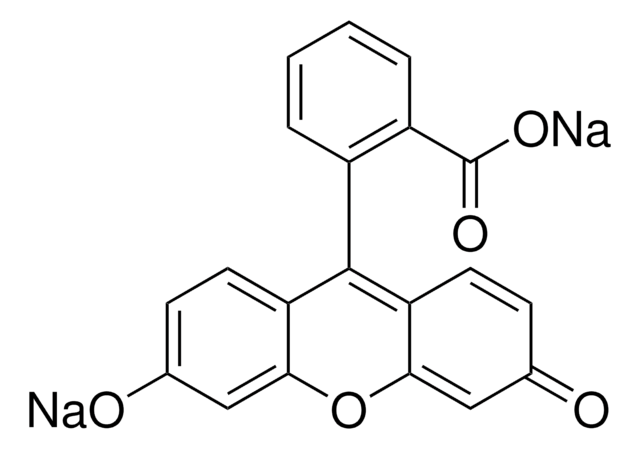46960
Fluorescein sodium salt
BioReagent, suitable for fluorescence
Synonym(s):
Acid Yellow 73, NaFl, Sodium fluorescein, Yellow No. 8, D&C;Yellow No. 8, NaFluo, Uranine
About This Item
Recommended Products
product line
BioReagent
Quality Level
form
powder
technique(s)
titration: suitable
fluorescence
λex 460 nm; λem 515 nm(lit.)
λex 490 nm; λem 514 nm in 0.1 M Tris pH 8.0
suitability
suitable for fluorescence
SMILES string
[Na+].[Na+].[O-]c1ccc2c(Oc3cc([O-])ccc3C24OC(=O)c5ccccc45)c1
InChI
1S/C20H12O5.2Na/c21-11-5-7-15-17(9-11)24-18-10-12(22)6-8-16(18)20(15)14-4-2-1-3-13(14)19(23)25-20;;/h1-10,21-22H;;/q;2*+1/p-2
InChI key
RGPLGPBQJOQFJS-UHFFFAOYSA-L
Looking for similar products? Visit Product Comparison Guide
General description
Application
Xanthene fluorophores, like Fluorescein Sodium Salt (FSS), are versatile compounds used across diverse fields of chemistry and life sciences.
Storage Class
11 - Combustible Solids
wgk_germany
WGK 1
flash_point_f
423.7 °F - Pensky-Martens closed cup
flash_point_c
217.6 °C - Pensky-Martens closed cup
ppe
Eyeshields, Gloves, type N95 (US)
Certificates of Analysis (COA)
Search for Certificates of Analysis (COA) by entering the products Lot/Batch Number. Lot and Batch Numbers can be found on a product’s label following the words ‘Lot’ or ‘Batch’.
Already Own This Product?
Find documentation for the products that you have recently purchased in the Document Library.
Customers Also Viewed
Our team of scientists has experience in all areas of research including Life Science, Material Science, Chemical Synthesis, Chromatography, Analytical and many others.
Contact Technical Service





